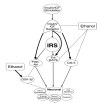Role of central nervous system insulin resistance in fetal alcohol spectrum disorders
- PMID: 21063035
- PMCID: PMC3113413
Role of central nervous system insulin resistance in fetal alcohol spectrum disorders
Abstract
Fetal alcohol spectrum disorder (FASD) is the most common preventable cause of mental retardation in the USA. Ethanol impairs neuronal survival and function by two major mechanisms: 1) it inhibits insulin signaling required for viability, metabolism, synapse formation, and acetylcholine production; and 2) it functions as a neurotoxicant, causing oxidative stress, DNA damage and mitochondrial dysfunction. Ethanol inhibition of insulin signaling is mediated at the insulin receptor (IR) level and caused by both impaired receptor binding and increased activation of phosphatases that reverse IR tyrosine kinase activity. As a result, insulin activation of PI3K-Akt, which mediates neuronal survival, motility, energy metabolism, and plasticity, is impaired. The neurotoxicant effects of ethanol promote DNA damage, which could contribute to mitochondrial dysfunction and oxidative stress. Therefore, chronic in utero ethanol exposure produces a dual state of CNS insulin resistance and oxidative stress, which we postulate plays a major role in ethanol neurobehavioral teratogenesis. We propose that many of the prominent adverse effects of chronic prenatal exposure to ethanol on CNS development and function may be prevented or reduced by treatment with peroxisome-proliferated activated receptor (PPAR) agonists which enhance insulin sensitivity by increasing expression and function of insulin-responsive genes, and reducing cellular oxidative stress.
Figures



Similar articles
-
Chronic ethanol exposure causes mitochondrial dysfunction and oxidative stress in immature central nervous system neurons.Acta Neuropathol. 2007 Jun;113(6):659-73. doi: 10.1007/s00401-007-0199-4. Epub 2007 Mar 13. Acta Neuropathol. 2007. PMID: 17431646
-
Ethanol inhibition of aspartyl-asparaginyl-beta-hydroxylase in fetal alcohol spectrum disorder: potential link to the impairments in central nervous system neuronal migration.Alcohol. 2009 May;43(3):225-40. doi: 10.1016/j.alcohol.2008.09.009. Alcohol. 2009. PMID: 19393862 Free PMC article.
-
Impact of Prenatal Dietary Soy on Cerebellar Neurodevelopment and Function in Experimental Fetal Alcohol Spectrum Disorder.Nutrients. 2025 Feb 26;17(5):812. doi: 10.3390/nu17050812. Nutrients. 2025. PMID: 40077682 Free PMC article.
-
A review of interventions against fetal alcohol spectrum disorder targeting oxidative stress.Int J Dev Neurosci. 2018 Dec;71:140-145. doi: 10.1016/j.ijdevneu.2018.09.001. Epub 2018 Sep 8. Int J Dev Neurosci. 2018. PMID: 30205148 Review.
-
Fetal alcohol spectrum disorders and abnormal neuronal plasticity.Neuroscientist. 2011 Jun;17(3):274-87. doi: 10.1177/1073858410383336. Epub 2011 Mar 7. Neuroscientist. 2011. PMID: 21383101 Free PMC article. Review.
Cited by
-
Chronic prenatal ethanol exposure increases adiposity and disrupts pancreatic morphology in adult guinea pig offspring.Nutr Diabetes. 2012 Dec 17;2(12):e57. doi: 10.1038/nutd.2012.31. Nutr Diabetes. 2012. PMID: 23247731 Free PMC article.
-
Developmental consequences of fetal exposure to drugs: what we know and what we still must learn.Neuropsychopharmacology. 2015 Jan;40(1):61-87. doi: 10.1038/npp.2014.147. Epub 2014 Jun 18. Neuropsychopharmacology. 2015. PMID: 24938210 Free PMC article. Review.
-
Alterations in Insulin Levels in Adults with Prenatal Alcohol Exposure.Alcohol Clin Exp Res. 2021 Mar;45(3):500-506. doi: 10.1111/acer.14559. Epub 2021 Feb 24. Alcohol Clin Exp Res. 2021. PMID: 33486796 Free PMC article.
-
Molecular Study of the Protective Effect of a Low-Carbohydrate, High-Fat Diet against Brain Insulin Resistance in an Animal Model of Metabolic Syndrome.Brain Sci. 2023 Sep 28;13(10):1383. doi: 10.3390/brainsci13101383. Brain Sci. 2023. PMID: 37891752 Free PMC article.
-
Inhibition of FAAH and activation of PPAR: new approaches to the treatment of cognitive dysfunction and drug addiction.Pharmacol Ther. 2013 Apr;138(1):84-102. doi: 10.1016/j.pharmthera.2013.01.003. Epub 2013 Jan 16. Pharmacol Ther. 2013. PMID: 23333350 Free PMC article. Review.
References
-
- Alcohol use among women of childbearing age--United States, 1991-1999. MMWR Morb Mortal Wkly Rep. 2002;51:273–6. - PubMed
-
- Riley EP, McGee CL. Fetal alcohol spectrum disorders: an overview with emphasis on changes in brain and behavior. Exp Biol Med (Maywood) 2005;230:357–65. - PubMed
-
- Astley SJ. Fetal alcohol syndrome prevention in Washington State: evidence of success. Paediatr Perinat Epidemiol. 2004;18:344–51. - PubMed
-
- Lupton C, Burd L, Harwood R. Cost of fetal alcohol spectrum disorders. Am J Med Genet C Semin Med Genet. 2004;127:42–50. - PubMed
Publication types
MeSH terms
Substances
Grants and funding
- AA-12908/AA/NIAAA NIH HHS/United States
- R37 AA011431/AA/NIAAA NIH HHS/United States
- AA-11431/AA/NIAAA NIH HHS/United States
- R01 AA012908/AA/NIAAA NIH HHS/United States
- R56 AA011431/AA/NIAAA NIH HHS/United States
- AA-16126/AA/NIAAA NIH HHS/United States
- R01 AA011431/AA/NIAAA NIH HHS/United States
- AA-02169/AA/NIAAA NIH HHS/United States
- R37 AA002666/AA/NIAAA NIH HHS/United States
- R01 AA008169/AA/NIAAA NIH HHS/United States
- AA-02666/AA/NIAAA NIH HHS/United States
- K24 AA016126/AA/NIAAA NIH HHS/United States
- R01 AA002666/AA/NIAAA NIH HHS/United States
LinkOut - more resources
Full Text Sources
Medical
Research Materials
